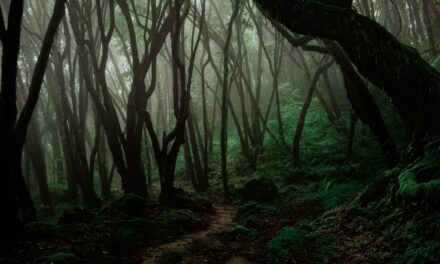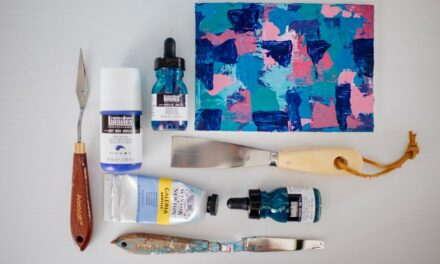Salt is a remarkable substance that has found its way into the realm of watercolour painting, offering artists a unique method to create captivating textures and effects. When sprinkled onto wet paint, salt absorbs the moisture and creates a fascinating interplay of colour and texture. This technique can evoke a sense of spontaneity and organic beauty, as the salt crystals form intricate patterns that are often unpredictable.
The result is a stunning visual experience that can transform a simple wash into a dynamic landscape or an abstract piece. Moreover, the versatility of salt extends beyond mere texture. Different types of salt can yield varying results, allowing artists to experiment with their work.
For instance, coarse sea salt produces larger, more pronounced textures, while fine table salt creates subtler effects. This adaptability makes salt an invaluable tool in the artist’s arsenal, enabling them to explore a wide range of styles and techniques. By incorporating salt into their practice, artists can push the boundaries of traditional watercolour painting and discover new dimensions in their work.
Summary
- Salt can create unique textures in watercolor by absorbing the paint and creating a mottled effect
- Alcohol can be used to create interesting effects in watercolor by lifting and blending the paint
- Unconventional materials such as plastic wrap, sponges, and even household items can be used to create interesting textures and effects in watercolor painting
- Experiment with different types of salt and alcohol to achieve varied textures and effects in watercolor
- Incorporating unconventional tools into watercolor painting can add depth and creativity to your artwork, so don’t be afraid to experiment
Exploring the Effects of Alcohol in Watercolor Painting
Alcohol, particularly isopropyl alcohol, is another unconventional medium that can be employed in watercolour painting to achieve striking effects. When applied to wet watercolour, alcohol creates a fascinating reaction that can produce unexpected patterns and textures. The alcohol repels the watercolour pigments, resulting in a unique separation that can resemble organic forms or abstract designs.
This technique allows artists to explore the fluidity of watercolour in a new light, creating pieces that are both visually arresting and conceptually intriguing. The use of alcohol in watercolour painting also opens up avenues for experimentation with layering and transparency.
This layering technique can lead to stunning visual contrasts, as the alcohol interacts with the underlying pigments. By embracing alcohol as a tool in their practice, artists can expand their creative vocabulary and develop a distinctive style that sets their work apart from traditional watercolour techniques.
Beyond Traditional Tools: Unconventional Materials for Watercolor Art
In the world of watercolour painting, artists are increasingly turning to unconventional materials to enhance their creative expression. Beyond salt and alcohol, a plethora of items can be repurposed to create unique effects. For instance, sponges, plastic wrap, and even household items like toothbrushes can be employed to manipulate paint in innovative ways.
Each material brings its own character to the artwork, allowing for a diverse range of textures and patterns that traditional brushes may not achieve. Additionally, natural materials such as leaves or feathers can be used to imprint shapes onto wet paint, creating organic forms that resonate with nature. This approach not only adds an element of surprise but also encourages artists to engage with their environment in new ways.
By stepping outside the confines of conventional tools, artists can cultivate a sense of playfulness and experimentation in their work, leading to unexpected discoveries and artistic growth.
How to Use Salt and Alcohol to Create Unique Textures in Watercolor
Combining salt and alcohol in watercolour painting can yield extraordinary results that elevate an artwork’s visual impact. To begin this process, an artist should start with a wet wash of watercolour on their chosen paper. Once the paint is applied, they can sprinkle salt over specific areas while the paint is still damp.
As the salt absorbs moisture, it will draw pigment towards it, creating beautiful blooms and textures that add depth to the composition. After allowing the salt to work its magic for a few moments, an artist can introduce alcohol into the mix. By using a dropper or brush to apply alcohol onto the wet paint, they will witness an immediate reaction as the alcohol repels the pigments.
This interaction creates intricate patterns that contrast beautifully with the textures formed by the salt. The combination of these two unconventional materials not only enhances the visual complexity of the piece but also invites spontaneity into the creative process, encouraging artists to embrace unpredictability in their work.
Experimenting with Different Types of Salt and Alcohol for Varied Effects
The world of salt and alcohol offers a rich tapestry of possibilities for artists willing to experiment with different types and applications. For instance, coarse sea salt can create bold textures that stand out prominently against the smooth washes of watercolour, while finer salts may yield more delicate effects that blend seamlessly into the background. Artists can also explore flavoured salts or coloured salts for added visual interest, pushing the boundaries of traditional colour palettes.
Similarly, varying concentrations of alcohol can lead to different results when applied to wet paint. Higher concentrations may produce more pronounced effects, while lower concentrations might create subtler interactions. By experimenting with these variables, artists can develop a deeper understanding of how each material behaves and how they can manipulate it to achieve their desired outcomes.
This exploration not only enhances technical skills but also fosters creativity and innovation within their artistic practice.
Tips and Tricks for Incorporating Unconventional Tools into Watercolor Painting
Starting Small
Incorporating unconventional tools into watercolour painting requires a willingness to experiment and adapt one’s techniques. One effective tip is to start small; rather than attempting an entire piece with new materials at once, artists should test them on scrap paper first. This allows for exploration without the pressure of creating a finished work.
Another useful strategy is to embrace layering techniques when using unconventional tools. For example, an artist might begin with a traditional wash before introducing salt or alcohol at various stages of drying.
Tracking Success and Inspiring Future Projects
This approach allows for greater control over the final outcome while still benefiting from the unique effects these materials provide. Additionally, keeping a journal or sketchbook dedicated to experiments can help track successful techniques and inspire future projects.
Pushing the Boundaries: Using Unconventional Tools to Push the Limits of Watercolor Art
The beauty of watercolour painting lies in its inherent fluidity and unpredictability; however, by incorporating unconventional tools, artists can push these boundaries even further. The use of materials like sponges or plastic wrap not only adds texture but also challenges traditional notions of what constitutes a watercolour painting. By embracing these tools, artists are encouraged to think outside the box and redefine their creative processes.
Moreover, pushing boundaries often leads to new artistic identities. As artists experiment with unconventional tools and techniques, they may discover unique styles that resonate with their personal vision. This journey of exploration fosters growth and innovation within their practice, allowing them to carve out a niche that reflects their individuality while contributing to the broader conversation within the art community.
The Future of Watercolor: Embracing Unconventional Tools for Innovation and Creativity
As we look towards the future of watercolour painting, it is clear that embracing unconventional tools will play a pivotal role in shaping its evolution. The art world is constantly changing, influenced by new technologies and cultural shifts; thus, artists must remain adaptable and open-minded in their approach. By integrating unconventional materials into their practice, they not only enhance their own creativity but also inspire others to explore new possibilities within this timeless medium.
Furthermore, as more artists share their experiences with unconventional tools through social media platforms and workshops, a vibrant community emerges around innovation in watercolour painting. This collective exploration fosters collaboration and dialogue among artists from diverse backgrounds, enriching the art form as a whole. Ultimately, by embracing unconventional tools and techniques, artists are not just creating unique works; they are contributing to an ongoing narrative that celebrates creativity, experimentation, and the limitless potential of watercolour art.
If you are interested in exploring more unconventional techniques in art, you may enjoy reading the article


